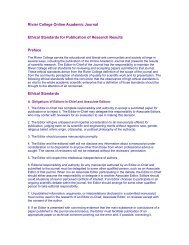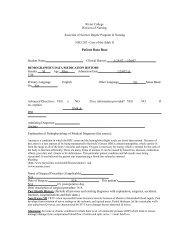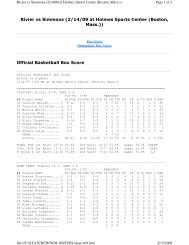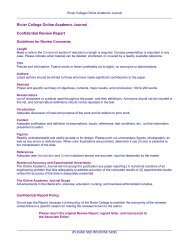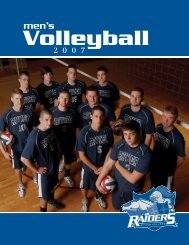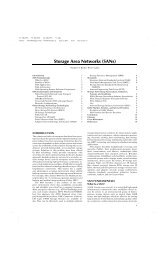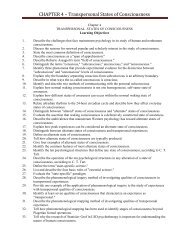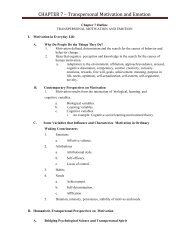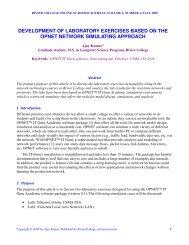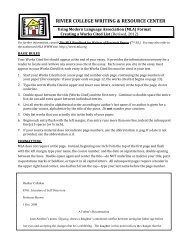Wireless Application Protocol - Rivier University
Wireless Application Protocol - Rivier University
Wireless Application Protocol - Rivier University
You also want an ePaper? Increase the reach of your titles
YUMPU automatically turns print PDFs into web optimized ePapers that Google loves.
<strong>Rivier</strong> College<br />
Computer Science Department<br />
CS553 - Introduction to Network Technology (Prof. Mr. Riabov)<br />
<strong>Wireless</strong> Communication Methodologies<br />
&<br />
<strong>Wireless</strong> <strong>Application</strong> <strong>Protocol</strong><br />
(Final Project)<br />
By Sankara Krishnaswamy<br />
31 Chadwick Circle<br />
Apt # E<br />
Nashua<br />
NH – 03062<br />
Ph: 603 – 791 – 8070 (W)<br />
603 – 888 – 0053 (H)<br />
Email: krisj1@hotmail.com<br />
December 4 - 2001 1
<strong>Rivier</strong> College<br />
Computer Science Department<br />
CS553 - Introduction to Network Technology (Prof. Mr. Riabov)<br />
Executive Summary<br />
<strong>Wireless</strong> is a term used to describe telecommunications in which electromagnetic waves (rather<br />
than some form of wire) carry the signal over part or the entire communication path. In the 21-<br />
century, wireless communication and high-speed communication incorporating computation<br />
power, mobile network/internet access capability, and consumer electronics, become emerging<br />
technologies. <strong>Wireless</strong> communications are transmitted through the air via radio waves of various<br />
frequencies. Radio frequency radiation (RFR) is one of several types of electromagnetic radiation.<br />
Data transmission in a <strong>Wireless</strong> Communication is done by means of an unguided medium.<br />
Antennas are used to transmit the signal. There are different kinds of antennas like Whip, Panel<br />
and Dish. Antennas need to be placed at specific heights in relation to one another in order to<br />
transmit and receive signals. As a result, height is a determining factor in the design and siting of<br />
wireless communications facilities.<br />
Analog and Digital technologies are the technologies that are used in the <strong>Wireless</strong><br />
Communication Traditionally cellular phones have utilized analog transmission signals. But<br />
Analog technology has the noise pick up issue, which makes the technology inefficient. In order<br />
to diminish this noise and to provide greater calling capacity per channel, the cellular industry is<br />
beginning to use digital transmission signals. Digital technology has two forms: time division<br />
multiple access (TDMA) and code division multiple access (CDMA).<br />
There are various wireless communications and controls that are available like Global System for<br />
Mobile communication (GSM), Enhanced Data GSM Environment (EDGE), General Packet Radio<br />
Service (GPRS), I-mode, Bluetooth Technology, <strong>Wireless</strong> <strong>Application</strong> <strong>Protocol</strong> (WAP).<br />
This paper has two sections. The first section explains the wireless communication in general and<br />
how data transmission is done in wireless. It explains the analog and digital technologies It then<br />
analyses the two digital technologies (TDMA.CDMA). The communication control that are<br />
discussed in this papers are Global System for Mobile Communication (GSM), Enhanced Data<br />
GSM Environment (EDGE), General Packet Radio Service (GPRS), I-mode, Bluetooth<br />
Technology, <strong>Wireless</strong> <strong>Application</strong> <strong>Protocol</strong> (WAP).<br />
Several wireless communication protocols exist today, and new ones are being developed in the<br />
quest for satisfying customer demand for efficient information retrieval as the industry's<br />
companies are competing for the market share in the new wireless world. The second section of<br />
the paper will completely analyze the <strong>Wireless</strong> <strong>Application</strong> <strong>Protocol</strong>. The <strong>Wireless</strong> <strong>Application</strong><br />
December 4 - 2001 2
<strong>Rivier</strong> College<br />
Computer Science Department<br />
CS553 - Introduction to Network Technology (Prof. Mr. Riabov)<br />
<strong>Protocol</strong>, commonly know as WAP, is an important development in the wireless industry because<br />
of its attempt to develop an open standard for wireless protocols, independent of vendor and air<br />
link. This section discusses WAP starting from evolution, technical architecture of WAP and how<br />
does WAP work. It also describes the advantages and the disadvantages of WAP and finally the<br />
future of WAP.<br />
December 4 - 2001 3
<strong>Rivier</strong> College<br />
Computer Science Department<br />
CS553 - Introduction to Network Technology (Prof. Mr. Riabov)<br />
Contents<br />
1.0 <strong>Wireless</strong> Communication Methodologies<br />
1.1 - What is <strong>Wireless</strong><br />
1.2 - Data Transmission in <strong>Wireless</strong><br />
1.3 - Analog and Digital Technologies<br />
1.3.1 - Time division multiple access (TDMA)<br />
1.3.2 - Code division multiple access (CDMA)<br />
1.4 - Examples of wireless communications and control<br />
1.4.1 - Global System for Mobile Communication (GSM)<br />
1.4.2 - Enhanced Data GSM Environment (EDGE)<br />
1.4.3 - General Packet Radio Service (GPRS)<br />
1.4.4 - I-mode<br />
1.4.5 - Bluetooth Technology<br />
1.4.6 - <strong>Wireless</strong> <strong>Application</strong> <strong>Protocol</strong> (WAP)<br />
2.0 The <strong>Wireless</strong> <strong>Application</strong> <strong>Protocol</strong><br />
2.1 - General Aspects of WAP<br />
2.2 - Principle<br />
3.0 -Technical Analysis of WAP<br />
3.1 - The WAP <strong>Protocol</strong> Stack<br />
3.1.1 - <strong>Application</strong> Layer - <strong>Wireless</strong> <strong>Application</strong> Environment (WAE)<br />
3.1.2 - Session Layer - <strong>Wireless</strong> Session <strong>Protocol</strong> (WSP)<br />
3.1.3 - Transaction <strong>Protocol</strong> - <strong>Wireless</strong> Transaction <strong>Protocol</strong> (WTP)<br />
3.1.4 - Transport Layer <strong>Protocol</strong> - <strong>Wireless</strong> Transport Layer Security (WTLS)<br />
3.1.5 - Datagram <strong>Protocol</strong> - <strong>Wireless</strong> Datagram <strong>Protocol</strong> (WDP)<br />
3.1.6 - Bearer Service<br />
3.2 - How does WAP work?<br />
3.3 - Comparison of World Wide Web and <strong>Wireless</strong> <strong>Application</strong> <strong>Protocol</strong><br />
3.4 - Advantages<br />
3.5 - Disadvantages of WAP architecture<br />
3.6 – Security Issues<br />
4.0 - Future of WAP<br />
5.0 – Conclusion<br />
6.0 - References<br />
December 4 - 2001 4
<strong>Rivier</strong> College<br />
Computer Science Department<br />
CS553 - Introduction to Network Technology (Prof. Mr. Riabov)<br />
<strong>Wireless</strong> Communication Methodologies<br />
1.1 What is <strong>Wireless</strong>?<br />
<strong>Wireless</strong> is a term used to describe telecommunications in which electromagnetic waves (rather<br />
than some form of wire) carry the signal over part or the entire communication path. Some<br />
monitoring devices, such as intrusion alarms, employ acoustic waves at frequencies above the<br />
range of human hearing; these are also sometimes classified as wireless.<br />
1.2 Data Transmission in <strong>Wireless</strong><br />
<strong>Wireless</strong> communications are transmitted through the air via radio waves of various frequencies.<br />
Radio frequency radiation (RFR) is one of several types of electromagnetic radiation. A cellular<br />
operates at frequencies between 800 and 900 MHz, and PCS operates at both 900 MHz as well<br />
as between 1,850 and 2,200 MHz.<br />
Data transmission generally can happen using Guided Media (propagation is done though twisted<br />
pair, coaxial cable or optical fiber) or using unguided media (propagation is done though air,<br />
water, vacuum). Data transmission in a <strong>Wireless</strong> Communication is done by means of an<br />
unguided medium. In an unguided medium transmission and reception are achieved by means of<br />
an antenna. In the case of wireless for transmission the antenna radiates electromagnetic energy<br />
into the medium (usually air), and for reception, the antenna picks up electromagnetic waves from<br />
the surrounding medium.<br />
The transmission is classified into directional and omni directional. In the case of directional<br />
configuration the transmitting antenna puts out a focused electromagnetic beam. The transmitting<br />
and receiving antennas must be aligned carefully. In omni directional configuration the<br />
transmitted signal spreads out in all direction and can be received by many antennas. It purely<br />
depends on the signal frequency, the higher the frequency of a signal, the more possibility of<br />
focusing into a directional beam. If the frequency range of 2Ghz to 40Ghz are referred as<br />
microwave frequencies. This frequency makes it possible to have directional configuration.<br />
Frequency range of 30Mhz to 1Ghz will be using omni directional configuration.<br />
December 4 - 2001 5
<strong>Rivier</strong> College<br />
Computer Science Department<br />
CS553 - Introduction to Network Technology (Prof. Mr. Riabov)<br />
Microwave signals propagate in straight lines and are affected very little by the troposphere. They<br />
are not refracted or reflected by ionized regions in the upper atmosphere. Microwave beams do<br />
not readily diffract around barriers such as hills, mountains, and large human-made structures.<br />
Some attenuation (Loss of strength of the signal) occurs when microwave energy passes through<br />
trees and frame houses.<br />
There are three general types of transmitting and receiving antennas used in the wireless<br />
communications technology. These include whip antennas, panel antennas, and dish antennas<br />
as shown in Figure-1. While whip and panel antennas are used to transmit and receive radio<br />
waves carrying conversation signals, dish antennas provide the link between the central<br />
computer switching system and the various whip and panel antennas used throughout the mobile<br />
conversation.<br />
Figure - 1<br />
A common type of microwave antenna is the parabolic “dish”. It has a size of about 3m in<br />
diameter. These antennas are mounted in a substantially heights above the ground level. With<br />
no intervening obstacles the maximum distance between the antenna is d=7.14 Kh. Here d is the<br />
distance between the antennas in kilometers, h is the antenna height in meters and K is an<br />
adjustment factor to account for the fact that microwaves are bent or refracted with the curvature<br />
of the earth and will hence propagate farther than the optical line of sight.<br />
Antennas need to be placed at specific heights in relation to one another in order to transmit and<br />
receive signals. As a result, height is a determining factor in the design and siting of wireless<br />
December 4 - 2001 6
<strong>Rivier</strong> College<br />
Computer Science Department<br />
CS553 - Introduction to Network Technology (Prof. Mr. Riabov)<br />
communications facilities. Typically there are three types of antenna support-structures used to<br />
place antennas at desired heights: lattice towers, monopoles, and building-attached facilities.<br />
1.3 Analog and Digital Technologies<br />
Traditionally, cellular phones have utilized analog transmission signals. In the analog technology,<br />
voice messages are electronically replicated and amplified as they are carried from the<br />
transmitting antenna to the receiving antenna. A problem with this technology is that the<br />
amplification procedure tends to pick up "noise," sometimes making the message difficult to hear.<br />
In order to diminish this noise and to provide greater calling capacity per channel, the cellular<br />
industry is beginning to use digital transmission signals. In the digital technology, voice messages<br />
are converted into digits (zeroes and ones) that represent sound intensities at specific points in<br />
time. Because natural pauses in the conversation are eliminated, more calling capacity becomes<br />
available from the same amount of spectrum, thus reducing the need for new sites.<br />
An added benefit is that the background noise that is generally heard in the analog system<br />
becomes inaudible. As illustrated in figure below the graphic difference between the two<br />
technologies is that analog signals are transmitted as continuous waves while digital technology<br />
converts the analog signal to binary digits. Figure- 2 shows the two different kinds of transmission<br />
signals.<br />
Figure - 2<br />
There are currently two forms of digital technology: time division multiple access (TDMA) and<br />
code division multiple access (CDMA). Both of these forms of digital technology attempt to<br />
provide multiple access over one frequency, or channel. While TDMA is expected to increase<br />
calling capacity three to ten times over analog technology, CDMA is expected to increase calling<br />
capacity by ten to twenty times.<br />
December 4 - 2001 7
<strong>Rivier</strong> College<br />
Computer Science Department<br />
CS553 - Introduction to Network Technology (Prof. Mr. Riabov)<br />
1.3.1Time division multiple access (TDMA)<br />
TDMA is a digital transmission technology that allows a number of users to access a single radiofrequency<br />
(RF) channel without interference by allocating unique time slots to each user within<br />
each channel. The TDMA digital transmission scheme multiplexes three signals over a single<br />
channel.<br />
TDMA is based on the IS-136 standard. The current TDMA standard for cellular divides a single<br />
channel into six time slots, with each signal using two slots, providing a 3 to 1 gain in capacity<br />
over advanced mobile-phone service (AMPS). Each caller is assigned a specific time slot for<br />
transmission. It offers efficient coverage and is well suited to emerging applications, such as<br />
wireless virtual private networks (VPNs),<br />
1.3.2 Code division multiple access (CDMA)<br />
CDMA is a coding scheme, used as a modulation technique, in which multiple channels are<br />
independently coded for transmission over a single wide band channel. In some communication<br />
systems, CDMA is used as an access method that permits carriers from different stations to use<br />
the same transmission equipment by using a wider bandwidth than the individual carriers. On<br />
reception, each carrier can be distinguished from the others by means of a specific modulation<br />
code, thereby allowing for the reception of signals that were originally overlapping in frequency<br />
and time. Thus, several transmissions can occur simultaneously within the same bandwidth, with<br />
the mutual interference reduced by the degree of orthogonality of the unique codes used in each<br />
transmission. CDMA permits a more uniform distribution of energy in the emitted bandwidth. The<br />
technology is used in ultra-high-frequency (UHF) cellular telephone systems in the 800-MHz and<br />
1.9-GHz bands.<br />
CDMA employs analog-to-digital conversion (ADC) in combination with spread spectrum<br />
technology. Audio input is first digitized into binary elements. The frequency of the transmitted<br />
signal is then made to vary according to a defined pattern (code), so it can be intercepted only by<br />
a receiver whose frequency response is programmed with the same code, so it follows exactly<br />
along with the transmitter frequency. There are trillions of possible frequency-sequencing codes;<br />
this enhances privacy and makes cloning difficult.<br />
December 4 - 2001 8
<strong>Rivier</strong> College<br />
Computer Science Department<br />
CS553 - Introduction to Network Technology (Prof. Mr. Riabov)<br />
The CDMA channel is nominally 1.23 MHz wide. CDMA networks use a scheme called soft<br />
handoff, which minimizes signal breakup as a handset passes from one cell to another. The<br />
combination of digital and spread-spectrum modes supports several times as many signals per<br />
unit bandwidth as analog modes. CDMA is compatible with other cellular technologies; this allows<br />
for nationwide roaming.<br />
1.4 Examples of wireless communications and control<br />
1.4.1 Global System for Mobile Communication (GSM) -- a digital mobile telephone system used<br />
in Europe and other parts of the world; the de facto wireless telephone standard in Europe. A<br />
GSM network is composed of several functional entities, whose functions and interfaces are<br />
specified. The GSM network can be divided into three broad parts. The Mobile Station is carried<br />
by the subscriber. The Base Station Subsystem controls the radio link with the Mobile Station.<br />
The Network Subsystem, the main part of which is the Mobile services Switching Center (MSC),<br />
performs the switching of calls between the mobile users, and between mobile and fixed network<br />
users. The MSC also handles the mobility management operations. Not shown is the Operations<br />
and Maintenance Center, which oversees the proper operation and setup of the network. The<br />
Mobile Station and the Base Station Subsystem communicate across the Um interface, also<br />
known as the air interface or radio link. The Base Station Subsystem communicates with the<br />
Mobile services Switching Center across an interface.<br />
A variety of data services are offered. GSM users can send and receive data, at rates up to 9600<br />
bps, to users on POTS (Plain Old Telephone Service), ISDN, Packet Switched Public Data<br />
Networks, and Circuit Switched Public Data Networks using a variety of access methods and<br />
protocols, such as X.25 or X.32. Since GSM is a digital network, a modem is not required<br />
between the user and GSM network, although an audio modem is required inside the GSM<br />
network to inter work with POTS.<br />
Other data services include Group 3 facsimile, as described in ITU-T recommendation T.30,<br />
which is supported by use of an appropriate fax adaptor. A unique feature of GSM, not found in<br />
older analog systems, is the Short Message Service (SMS). SMS is a bi-directional service for<br />
short alphanumeric (up to 160 bytes) messages. Messages are transported in a store-andforward<br />
fashion. For point-to-point SMS, a message can be sent to another subscriber to the<br />
service, and an acknowledgement of receipt is provided to the sender. SMS can also be used in a<br />
cell-broadcast mode, for sending messages such as traffic updates or news updates. Messages<br />
can also be stored in the SIM card for later retrieval.<br />
December 4 - 2001 9
<strong>Rivier</strong> College<br />
Computer Science Department<br />
CS553 - Introduction to Network Technology (Prof. Mr. Riabov)<br />
1.4.2 Enhanced Data GSM Environment (EDGE) -- a faster version of the Global System for<br />
Mobile (GSM) wireless service Universal Mobile Telecommunications System (UMTS) -- a<br />
broadband, packet-based system offering a consistent set of services to mobile computer and<br />
phone users no matter where they are located in the world. EDGE is intended to enable secondgeneration<br />
GSM (Global System for Mobile Communication) and TDMA (Time division Multiple<br />
Access) networks to transmit data at up to 384 kilobits per second (kbps). As it was initially<br />
developed for GSM systems only, it has also been called GSM384.<br />
1.4.3 General Packet Radio Service (GPRS) -- A packet-linked technology that enables highspeed<br />
(up to 171.2 kilobit per second) wireless Internet and other data communications. GPRS<br />
will offer a tenfold increase in data throughput rates, from 9.6kbit/s to 115kbit/s. Using a packet<br />
data service, subscribers are always connected and always on line so services will be easy and<br />
quick to access.<br />
GPRS involves overlaying a packet based air interface on the existing circuit switched GSM<br />
network. This gives the user an option to use a packet-based data service. To supplement a<br />
circuit switched network architecture with packet switching is quite a major upgrade. Packet<br />
switching means that GPRS radio resources are used only when users are actually sending or<br />
receiving data. Rather than dedicating a radio channel to a mobile data user for a fixed period of<br />
time, the available radio resource can be concurrently shared between several users. This<br />
efficient use of scarce radio resources means that large numbers of GPRS users can potentially<br />
share the same bandwidth and be served from a single cell.<br />
GPRS achieves Faster data speeds and "always on" mobility. Connection to an abundance of<br />
data sources around the world, through support for multiple protocols, including IP.<br />
1.4.4 I-Mode -- The world's first "smart phone" for Web browsing, first introduced in Japan;<br />
provides color and video over telephone sets. NTT DoCoMo’s I-Mode is widely used in Japan,<br />
and is branching out to Europe and the USA. It is also providing serious competition for WAP. I-<br />
Mode recently signed a partnership deal with AT&T <strong>Wireless</strong>.<br />
I-Mode is a proprietary service that allows users to connect directly to the Internet using Compact<br />
HTML (CHTML). It is a packet-switched service and is "always on." Users are charged only for<br />
downloading data. Most other wireless networks are circuit-switched and users are charged for<br />
December 4 - 2001 10
<strong>Rivier</strong> College<br />
Computer Science Department<br />
CS553 - Introduction to Network Technology (Prof. Mr. Riabov)<br />
connection time. There are about 20 million wireless Internet users are there in Japan using this<br />
I-Mode service.<br />
I-mode phones transmit data at a speed of 9600 bps. Although this sounds slow compared to<br />
ordinary 56kps computer modems, it is actually quite satisfactory for I-mode, since each email is<br />
limited to only 500 bytes and most I-modes sites are relatively lightweight (i.e., made up mostly of<br />
text data with very few graphics, averaging about 1.2K in size). Downloading email and I-mode<br />
pages usually takes only a few seconds. I-mode expects to introduce the world's first 3G (third<br />
generation) network based on the latest W-CDMA (Wideband Code Division Multiple Access)<br />
technology, which will speed data rates 40 times - and allow high-quality streaming video and<br />
audio. The advantage is that NTT DoCoMo built an Internet-style packet-switched network<br />
alongside its existing digital circuit-switched network in the beginning, and equipped its handsets<br />
with a micro- browser that understands cHTML a subset of HTML. Europe is only now beginning<br />
to build packet-switched (GPRS) networks.<br />
I-Mode also has security issues since they are into Mobile commerce (m-commerce) and it is<br />
conducted on I-mode including mobile banking and security trading. So security is a serious<br />
issue.<br />
1.4.5 Bluetooth Technology - Bluetooth is a simple, short-range Radio Frequency (RF)<br />
technology designed in 1998 by the leaders in the telecommunication and computer industries as<br />
the basis of truly wireless, global solution. This industry specification describes how mobile<br />
phones, computers, and personal digital assistants (PDA) can easily interconnect with each<br />
other and with home and business phones and computers using a short-range wireless<br />
connection.<br />
Each device is equipped with a microchip transceiver that transmits and receives in a previously<br />
unused frequency band of 2.45 GHz that is available globally (with some variation of bandwidth in<br />
different countries). In addition to data, up to three voice channels are available. Each device has<br />
a unique 48-bit address from the IEEE (Institute of Electrical and Electronics Engineers) 802<br />
standard. Connections can be point-to-point or multipoint. The maximum range is 10 meters.<br />
Data can be exchanged at a rate of 1 megabit per second (up to 2 Mbps in the second generation<br />
of the technology). A frequency hop scheme allows devices to communicate even in areas with a<br />
great deal of electromagnetic interference. Built-in encryption and verification is provided.<br />
December 4 - 2001 11
<strong>Rivier</strong> College<br />
Computer Science Department<br />
CS553 - Introduction to Network Technology (Prof. Mr. Riabov)<br />
The primary disadvantage of Bluetooth is interference. It does not compete with the HomeRF and<br />
802.11B standards vying for wireless networking dominance, but a pending FCC ruling allowing<br />
HomeRF to operate at a faster speed could cause interference with Bluetooth devices. Also,<br />
there are concerns with the 802.11b crowd about Bluetooth using the ISM (Instrument, Scientific<br />
and Medical) bandwidth. Also the farther away the Bluetooth devices are from the sending unit,<br />
there is more chance of interference in the presence of a <strong>Wireless</strong> Access Point. Another<br />
disadvantage is that Bluetooth-enabled devices at a range of 100 feet become seriously<br />
compromised when walls are present between devices. Also finally, the standard speed for<br />
wireless Ethernet connections is now approaching 10 Mbps and Bluetooth’s top speed is very<br />
low.<br />
1.4.6 <strong>Wireless</strong> <strong>Application</strong> <strong>Protocol</strong> (WAP) - a set of communication protocols to standardize the<br />
way that wireless devices, such as cellular telephones and radio transceivers, can be used for<br />
Internet access. The principle and the technical architecture are discussed in detail in the next<br />
section.<br />
December 4 - 2001 12
<strong>Rivier</strong> College<br />
Computer Science Department<br />
CS553 - Introduction to Network Technology (Prof. Mr. Riabov)<br />
The <strong>Wireless</strong> <strong>Application</strong> <strong>Protocol</strong><br />
2.1 General Aspects of WAP<br />
The <strong>Wireless</strong> <strong>Application</strong> <strong>Protocol</strong> is a protocol standard that designs the way for a mobile device<br />
to communicate to a server installed in a mobile network. For example it gives the framework<br />
used when a mobile phone talks to the server installed in the mobile phone network.<br />
The <strong>Wireless</strong> <strong>Application</strong> <strong>Protocol</strong>, commonly know as WAP, is an important development in the<br />
wireless industry because of its attempt to develop an open standard for wireless protocols,<br />
independent of vendor and air link.<br />
The WAP Forum was formed after US network operator Omnipoint issued a tender for the supply<br />
of mobile information services in early 1997. It received several responses from different<br />
suppliers using proprietary techniques for delivering the information such as Smart Messaging<br />
from Nokia and HDML from Phone.com (then called Unwired Planet). It was the WAP forum,<br />
which developed and deployed the <strong>Wireless</strong> <strong>Application</strong> <strong>Protocol</strong>. Industrial giants like Motorola,<br />
Nokia, Ericsson and phone.com are the founder members of the WAP forum. WAP is an attempt<br />
to define the standard for how content from the Internet is filtered for mobile communications.<br />
Content is now readily available on the Internet and WAP was designed as the overriding (rather<br />
than just one among many) way of making it easily available on mobile terminals.<br />
2.1 Principle<br />
The <strong>Wireless</strong> <strong>Application</strong> <strong>Protocol</strong> takes a client server approach. It incorporates a relatively<br />
simple microbrowser into the mobile phone, requiring only limited resources on the mobile phone.<br />
This makes WAP suitable for thin clients and early smart phones. WAP puts the intelligence in<br />
the WAP Gateways whilst adding just a microbrowser to the mobile phones themselves.<br />
Microbrowser-based services and applications reside temporarily on servers, not permanently in<br />
phones. The <strong>Wireless</strong> <strong>Application</strong> <strong>Protocol</strong> is aimed at turning a mass-market mobile phone into a<br />
"network-based smartphone".<br />
December 4 - 2001 13
<strong>Rivier</strong> College<br />
Computer Science Department<br />
CS553 - Introduction to Network Technology (Prof. Mr. Riabov)<br />
The philosophy behind the <strong>Wireless</strong> <strong>Application</strong> <strong>Protocol</strong>'s approach as per WAP Forum is to<br />
utilize as few resources as possible on the handheld device and compensate for the constraints<br />
of the device by enriching the functionality of the network.<br />
The <strong>Wireless</strong> <strong>Application</strong> <strong>Protocol</strong> is envisaged as a comprehensive and scaleable protocol<br />
designed for use with any mobile phone, from those with a one line display to a smart phone, any<br />
existing or planned wireless service such as the Short Message Service, Circuit Switched Data,<br />
Unstructured Supplementary Services Data (USSD) and General Packet Radio Service (GPRS).<br />
Another importance of WAP is the fact that it provides an evolutionary path for application<br />
developers and network operators to offer their services on different network types, bearers and<br />
terminal capabilities. The design of the WAP standard separates the application elements from<br />
the bearer being used. This helps in the migration of some applications from SMS or Circuit<br />
Switched Data to GPRS for example mobile networks, such as Code Division Multiple Access<br />
(CDMA), Global System for Mobiles (GSM), or Universal Mobile Telephone System (UMTS).<br />
WAP has been designed to work with all cellular standards and is supported by major worldwide<br />
wireless leaders such as AT&T <strong>Wireless</strong> and NTT DoCoMo.<br />
3.0 Technical Analysis of WAP<br />
Phone.com created a version of the standard Hyper Text Markup Language (HTML) internet<br />
protocols designed specifically for effective and cost effective information transfer across mobile<br />
networks. <strong>Wireless</strong> terminals incorporated a Handheld Device Markup Language (HDML)<br />
microbrowser, and Phone.com's Handheld Device Transport <strong>Protocol</strong> (HDTP) then linked the<br />
terminal to the UP.Link Server Suite which connected to the Internet or intranet where the<br />
information being requested resides. The Internet site content was tagged with HDML.<br />
<strong>Wireless</strong> <strong>Application</strong> <strong>Protocol</strong> embraced and extends the previously conceived and developed<br />
wireless data protocols.<br />
The <strong>Wireless</strong> <strong>Application</strong> <strong>Protocol</strong> has WMLS, WTP and WSP to take care of the above. WAP<br />
uses a built in microbrowser to do various following services.<br />
A Request is passed to a WAP Gateway that then retrieves the information from an Internet<br />
server either in standard HTML format or directly prepared for wireless terminals using WML. If<br />
December 4 - 2001 14
<strong>Rivier</strong> College<br />
Computer Science Department<br />
CS553 - Introduction to Network Technology (Prof. Mr. Riabov)<br />
the content being retrieved is in HTML format, a filter in the WAP Gateway may try to translate it<br />
into WML. To format data such as calendar entries and electronic business cards, the WML<br />
scripting language is available. This can be incorporated directly into the client device.<br />
The <strong>Wireless</strong> <strong>Application</strong> <strong>Protocol</strong> (WAP) is not just one protocol, it is the name of a whole suite<br />
of protocols. The suite is designed to make it possible to access Internet resources from hand<br />
held wireless devices (mobile phones or personal digital assistants PDA) in an efficient manner.<br />
3.1 The WAP <strong>Protocol</strong> Stack<br />
WAP has a layered architecture as shown in the diagram below:<br />
<strong>Wireless</strong> <strong>Application</strong> Environment (WAE)<br />
<strong>Wireless</strong> Session <strong>Protocol</strong> (WSP)<br />
<strong>Wireless</strong> Transaction <strong>Protocol</strong> (WTP)<br />
<strong>Wireless</strong> Transport Layer Security (WTLS)<br />
<strong>Wireless</strong> Datagram <strong>Protocol</strong> (WDP)<br />
Bearers<br />
GSM SMS USSD CDMA CDPD PHS<br />
(Figure -3 WAP <strong>Protocol</strong> Stack)<br />
3.1.1 <strong>Wireless</strong> <strong>Application</strong> Environment (WAE)<br />
WAE offers the software platform environment for the application software. WAE is built into the<br />
micro browser program. It works much like normal WWW browsers that interpret HTML and<br />
JavaScript. WAE consists of the <strong>Wireless</strong> Markup Language (WML), WMLScript, and <strong>Wireless</strong><br />
Telephony <strong>Application</strong> (WTA).<br />
<strong>Wireless</strong> Markup Language (WML)<br />
WML is WAP's markup language derived from HTML especially for wireless<br />
network characteristics. It is much like HTML in the World Wide Web. Since it is<br />
a Document Type Definition (DTD) of XML, it is a tag-based, Standard<br />
Generalized Markup Language like HTML.<br />
December 4 - 2001 15
<strong>Rivier</strong> College<br />
Computer Science Department<br />
CS553 - Introduction to Network Technology (Prof. Mr. Riabov)<br />
WMLScript<br />
WMLScript is WML's integrated scripting language, much like JavaScript or<br />
ECMA Script, that can control many functions of the browser and the phone itself<br />
by scripts downloaded from the server. See Appendix A for a WMLS example.<br />
<strong>Wireless</strong> Telephony <strong>Application</strong> (WTA)<br />
WTA is the telephony interface of WAE that can be used to control telephony<br />
functions of the device from WML, WMLScript or the network and to invoke<br />
functions by requests from the network.<br />
3.1.2 <strong>Wireless</strong> Session <strong>Protocol</strong> (WSP)<br />
It is designed to implement a request-response protocol much like the Hypertext Transfer<br />
<strong>Protocol</strong> (HTTP). Using these protocols, the client makes a request and then the server answers<br />
with a reply that we know as a response in HTTP terminology.<br />
WSP also includes some features not included in the HTTP protocol. These features are there<br />
because of the mobile nature of the WAP clients. For example, a mobile phone, which is a client,<br />
should not lose its connection to the server when it changes base stations.<br />
The WSP protocol offers two different services, Connectionless and Connection Oriented service.<br />
It is purely to the wish of the client to use either of the services. This is how the two services<br />
work.<br />
The connectionless service does not remember the context between two consecutive requests.<br />
Every request is handled on its own and there is no guarantee in what order two requests will be<br />
served. The client has to mark the requests with a unique transaction identifier (TID) and the<br />
server has to add this mark to the reply to allow the client to separate different replies from each<br />
other.<br />
The connection-oriented service does remember context between consecutive requests and does<br />
not have to use a TID to mark requests or replies.<br />
December 4 - 2001 16
<strong>Rivier</strong> College<br />
Computer Science Department<br />
CS553 - Introduction to Network Technology (Prof. Mr. Riabov)<br />
Both services are designed to provide the same functionality as HTTP and unreliable data<br />
transfer. HTTP uses ASCII strings to send protocol information between the client and the server.<br />
WSP does this in a better way of sending byte codes. This minimizes the data sent over the air.<br />
This way, the same information can be sent using much fewer bytes.<br />
The push facility in the WSP protocol does not have a counterpart in the HTTP protocol. A push is<br />
what is performed when a WSP server sends information to a client without a preceding request<br />
from the client.<br />
If it is a connection-oriented service, it provides various other services like session suspend and<br />
session resume functionality with session migration, reliable data push, protocol feature and<br />
negotiation. For example, when a client is connected using connection oriented WSP it may<br />
suspend the WSP session and resume it later. It may even be resumed over a different bearer.<br />
When this happens WSP resumes later on with a different barrier using SMS messages. This<br />
change in the underlying transport layer is called a session migration.<br />
In WSP connection oriented mode, the client and server may negotiate some protocol features to<br />
be used in the session. For example, the client and server could agree on the maximum number<br />
of outstanding requests.<br />
The <strong>Protocol</strong> Data Unit (PDU)<br />
The PDU differs a bit depending on whether connection oriented mode or connectionless WSP is<br />
used. Connection oriented mode does not require the transaction identifier (TID) and it must be<br />
sent in each PDU when using connectionless mode.<br />
TID TYPE Specific Contents<br />
The type field in the PDU explains how to understand or interpret the specific contents. For<br />
example it identifies types like Connect, Get, Push and Suspend. The WSP specification defines<br />
the allowed types and their assigned byte code.<br />
WSP implements the session services of WAP. Sessions can be connection-oriented and<br />
connectionless and they may be suspended and resumed at will.<br />
December 4 - 2001 17
<strong>Rivier</strong> College<br />
Computer Science Department<br />
CS553 - Introduction to Network Technology (Prof. Mr. Riabov)<br />
3.1.3 <strong>Wireless</strong> Transaction <strong>Protocol</strong> (WTP)<br />
WTP is <strong>Wireless</strong> <strong>Application</strong> <strong>Protocol</strong>’s transaction protocol. It works between the session<br />
protocol WSP and security protocol WTLS. It is responsible for delivering higher layer messages<br />
in a way that satisfies the demands of these upper layers. WTP chops data packets into lower<br />
level datagrams and concatenates received datagrams into useful data. Since datagrams are<br />
unreliable, WTP uses techniques like retransmission after timeouts and acknowledgement of<br />
messages for providing reliable service. WTP uses a transaction identifier (TID) in every<br />
message. The TID is used to associate a packet with a particular transaction.<br />
When the receiver receives a TID that is less than or equal to the TID that is in the buffer, then<br />
the message the receiver is getting may be a duplicate or a retransmitted message, which was<br />
lost earlier. Now the receiver will be able to ask the sender if the TID is valid or not. WTP uses<br />
primitive error handling. In the case of error, say a connection break etc the transaction is<br />
aborted.<br />
Depending on the demands of the application, WTP defines three classes of transaction, Class<br />
0,1 and 2. In Class 0 the sender sends a transaction to the receiver, but there is no assurance<br />
that the transaction will reach its destination. If the transaction reaches the destination then the<br />
receiver will not send acknowledgment to the sender. In Class 1 the transaction provides a<br />
reliable datagram service. If the sender does not get acknowledgment the sender will retransmit<br />
the message after some time. In Class 2 service the sender and receiver transfer<br />
acknowledgements promptly. Both sender and receiver are capable of re-transmitting messages<br />
if necessary.<br />
The WTP protocol has various protocol features. In some of the protocol features, both the client<br />
and the server send and receive packets. During this description of the protocol features, the<br />
sender is the one who starts the transaction by sending an Invoke message and the receiver is<br />
the recipient of that message. Features include:<br />
Message transfer : Depending on the class of service, various messages like Invoke message<br />
(first message to invoke the transaction), Verification (if the message sent is invalid verification<br />
process starts) , Hold on acknowledgement (If the receiver needs more time to process before<br />
sending acknowledgement this message is sent to avoid retransmission from the sender) , Result<br />
December 4 - 2001 18
<strong>Rivier</strong> College<br />
Computer Science Department<br />
CS553 - Introduction to Network Technology (Prof. Mr. Riabov)<br />
message (This is used when data from invoke message has been processed and then result<br />
message is sent), Last acknowledgement. (Sent when the last message of the transaction has<br />
been received).<br />
Retransmission : Retransmission of packets happens until acknowledgement arrives. This<br />
happens once the retransmission timer expires, then the sender retransmits the packet until<br />
sender gets acknowledgement from the receiver.<br />
Linking and Separation of Messages : To provide over the air efficiency there can be multiple<br />
WTP data units can be present in one datagram service data unit of the bearer network. By doing<br />
this only fewer transmissions will be required over the air. Linking of messages can be done for<br />
messages with the same source and destination address and the same source and destination<br />
port, essentially the same address information. A last acknowledgement of one transaction can<br />
also be concatenated with the new invoke message of the next transaction.<br />
Error Handling: During a transaction if a fatal error occurs then the transaction is aborted and the<br />
WTP user is informed with proper abort reason.<br />
Segmentation and Re-assembly (SAR): When the message length is going to exceed the<br />
maximum transfer unit (MTU) of the current bearer, the message will be split by the <strong>Wireless</strong><br />
Transfer <strong>Protocol</strong> into several packets. This is an optional feature. If Segmentation and Reassembly<br />
is not implemented in WTP, then the higher layer in the stack will take care of this<br />
operation.<br />
Abort Transaction: This is done when an abort request is made by the application. There are two<br />
kinds of aborts. One is the user requested abort, and the other one is by the invalid protocol<br />
feature. If a particular of the feature is tried and not implemented then the protocol aborts that<br />
request.<br />
Other features of WTP include getting information last acknowledgement, user<br />
acknowledgement, initiating multiple transactions, Transport Identifier verification and information<br />
on the Transport information items, etc.<br />
December 4 - 2001 19
<strong>Rivier</strong> College<br />
Computer Science Department<br />
CS553 - Introduction to Network Technology (Prof. Mr. Riabov)<br />
WTP <strong>Protocol</strong> Data Unit<br />
The header of this may have variable length. It consists of Transport Information Items called TPI.<br />
All the transport information items have Transaction <strong>Protocol</strong> Item Identification, Transaction<br />
<strong>Protocol</strong> Item data. <strong>Wireless</strong> Transport <strong>Protocol</strong> has defined only a few TPI. The use of TPIs<br />
allows for future extensions of the protocol.<br />
3.1.4 <strong>Wireless</strong> Transport Layer Security protocol (WTLS)<br />
This is an optional layer providing secure connections to the upper layers. WTLS does all<br />
cryptography-oriented features of WAP. WTLS handles crypting, decrypting, user authentications<br />
by digital signing, and data integrity checking. WTLS is based on the fixed network Transport<br />
Layer Security protocol (TLS), formerly known as Secure Sockets Layer (SSL).<br />
The security layer can be subdivided into Handshake and Record protocol layers. Handshake<br />
works somewhat similarly to the Transmission Control <strong>Protocol</strong>'s (TCP) three way handshake,<br />
with the exception that here it is just request and response kind of operation only.<br />
HandShake<br />
Client (C1) ------------------------------------------------------------------------------------------> Server (S1)<br />
(C1 Hello, Request Authentication of Server)<br />
Client (C1)
<strong>Rivier</strong> College<br />
Computer Science Department<br />
CS553 - Introduction to Network Technology (Prof. Mr. Riabov)<br />
Client (C1)
<strong>Rivier</strong> College<br />
Computer Science Department<br />
CS553 - Introduction to Network Technology (Prof. Mr. Riabov)<br />
WDP actually specifies how various existing bearer services should be used to provide a<br />
consistent service to the upper layers. This is done by adapting the protocol to the underlying<br />
bearer.<br />
Since different bearers have different features therefore some sections in the specification are<br />
bigger or smaller than others. For instance, the section on IP bearers is very short. As <strong>Wireless</strong><br />
Datagram <strong>Protocol</strong> one must use the UDP protocol from the IP-suite. Consider the following<br />
diagram, bearer B4 is the example of showing how as WDP one must use the UDP protocol from<br />
the IP-suite.<br />
Adaption of WDP<br />
<strong>Wireless</strong> Datagram <strong>Protocol</strong><br />
Bearer B1<br />
Bearer B2<br />
Bearer B3<br />
Bearer B4<br />
Adaption<br />
Adaption<br />
Adaption<br />
Service<br />
Bearer B3<br />
Service<br />
Bearer B2<br />
Service<br />
Bearer B1<br />
Service<br />
Physical Layer Air Link<br />
(Figure -4 Adaption of WDP)<br />
Say if one uses GSM SMS (Short Message Service) as the bearer, then WDP has to adapt to<br />
support port numbers. The adaptation process is described in the specification.<br />
3.1.6 Bearer Service<br />
December 4 - 2001 22
<strong>Rivier</strong> College<br />
Computer Science Department<br />
CS553 - Introduction to Network Technology (Prof. Mr. Riabov)<br />
Bearer Service is a telecommunication service that allows transmission of user information<br />
signals between user network interfaces.<br />
The WAP protocols are designed to operate over a variety of different bearer services. The<br />
bearers offer differing levels of quality of service with respect to throughput, error rate, and<br />
delays. The WAP protocols are designed to compensate for, or at least tolerate, these varying<br />
levels of service.<br />
Short Message Service (SMS): It has the ability to send and receive text messages to and from<br />
mobile telephones. The text can be comprised of words or numbers or an alphanumeric<br />
combination. SMS was created as part of the GSM Phase 1 standard. Each short message is up<br />
to 160 characters in length. WAP services can be developed based on SMS.<br />
Circuit Switch Data (CSD): Most of the trial WAP based services use CSD as the underlying<br />
bearer. However, CSD lacks immediacy- a dial up connection taking about 10 seconds is<br />
required to connect the WAP client to the WAP Gateway.<br />
Unstructured Supplementary Services Data (USSD): Unstructured Supplementary Services Data<br />
(USSD) is a means of transmitting information or instructions over a GSM network. USSD has<br />
some similarities with SMS since both use the (Global System for Mobiles) GSM network's<br />
signaling path. Unlike SMS, USSD is not a store and forward service and is session-oriented<br />
such that when a user accesses a USSD service, a session is established and the radio<br />
connection stays open until the user, application, or time out releases it.<br />
3.2 How does WAP work?<br />
Internet servers have resources stored from all around the world. A web client can download the<br />
information from the web servers. The interaction happens using HTTP protocol (Hypertext<br />
Transfer <strong>Protocol</strong>). <strong>Wireless</strong> <strong>Application</strong> <strong>Protocol</strong> does not include HTTP. Instead a <strong>Wireless</strong><br />
<strong>Application</strong> <strong>Protocol</strong> client uses the <strong>Wireless</strong> Session <strong>Protocol</strong> (WSP) to retrieve information from<br />
the server.<br />
Since an Internet web server and WAP use different protocol approaches, this creates a<br />
contradiction between the way Internet servers work and the WAP approach to retrieving<br />
information.<br />
December 4 - 2001 23
<strong>Rivier</strong> College<br />
Computer Science Department<br />
CS553 - Introduction to Network Technology (Prof. Mr. Riabov)<br />
So directly a WAP client cannot download information from a web server. Now to solve this the<br />
WAP client should use a translator between HTTP and WSP. This is called a proxy server. The<br />
proxy server in WAP is called the WAP Gateway. The existence of a WAP gateway is totally<br />
transparent to the WAP client or the web server. WAP process of downloading information from<br />
World Wide Web server is shown in the following figure. (Figure -5)<br />
Figure - 5 WAP Process for downloading information from World Wide Web server<br />
Client<br />
The client makes (A mobile phone) establishes the connection to the remote access server.<br />
Once the connection is established then the remote access server will be the forwarding agent to<br />
and from the client. The client runs a WAP application (typical client show in Figure - 6) like a<br />
browser, and makes the WSP request to the gateway.<br />
Figure - 6 A typical WAP enabled Client<br />
December 4 - 2001 24
<strong>Rivier</strong> College<br />
Computer Science Department<br />
CS553 - Introduction to Network Technology (Prof. Mr. Riabov)<br />
Server<br />
A server will run a web browser and will not understand WML and will understand only HTTP.<br />
Since the gateway takes care of transferring the request to HTTP from WSP, the server will not<br />
even know that there is such a translation happening in between. It basically responds to the<br />
HTTP request and processes it.<br />
Gateway<br />
The Gateway is generally located in the same local network of the remote access server. It also<br />
takes care of making the message suitable for the client. Basically a WAP client only understands<br />
the binary encoding of WML even though a page is written in WML. The Gateway takes care of<br />
this transfer and makes it suitable for the client.<br />
Say a client needs a document (Uniform Resource Identifier URI) from the Web. It sends a WSP<br />
request to the Gateway. The Gateway parses the client's request then the Gateway receives the<br />
request and takes the responsibility of translation of the request between the WSP and HTTP<br />
protocols. Then it makes a HTTP request for the document specified in the URI. Then the server<br />
will respond to the request of the Gateway. The Gateway parses the response from the HTTP<br />
server. If the content is WML then it takes care of compiling it and creating a binary encoding of<br />
WML. The Gateway then sends a WSP response to the client. The Client is presented with the<br />
document it requested.<br />
3.3 Comparison of World Wide Web and <strong>Wireless</strong> <strong>Application</strong> <strong>Protocol</strong><br />
WAP uses the <strong>Wireless</strong> Markup Language (WML) for application contents in the same way what<br />
Hyper Text Mark-up Language (HTML) is used in WWW.<br />
In the Internet model there is a client and a server. The Internet is used for transmission. The<br />
WWW client sends a request to the WWW server and the server sends a response for that<br />
request. The Internet is used as the transmission medium. In the WAP model, the same client<br />
server model is used but there is a Proxy/Gateway between the server and the client to allow<br />
protocol conversion and encoding plus encoding of WML.<br />
WMLScript makes it possible to add procedural logic and computational functions to WAP based<br />
services like Javascript in HTML.<br />
December 4 - 2001 25
<strong>Rivier</strong> College<br />
Computer Science Department<br />
CS553 - Introduction to Network Technology (Prof. Mr. Riabov)<br />
<strong>Wireless</strong> devices have slow connection speeds and small screen sizes. In small terminals, power<br />
consumption is very important and these terminals can’t provide microprocessor resources like in<br />
a PC. <strong>Wireless</strong> networks have high latency compared to wired networks. WAP is optimized to<br />
fulfill these requirements.<br />
WAP uses the same addressing model as the one used in the Internet (URL). WAP also can use<br />
URIs(Uniform Resource identifiers) for addressing resources that are not necessarily accessed<br />
using well-known protocols.<br />
WAP allows <strong>Wireless</strong> Telephony <strong>Application</strong>s that are not available in the WWW.<br />
WWW and WAP Architecture<br />
WWW<br />
HTML, Javascript, VBScript<br />
Gif and Jpeg graphics<br />
WAP<br />
<strong>Wireless</strong> <strong>Application</strong> Environment(WAE) WML<br />
and WMLScript<br />
Wbmp<br />
<strong>Wireless</strong> Session <strong>Protocol</strong>(WSP)<br />
HTTP<br />
<strong>Wireless</strong> Transaction <strong>Protocol</strong>(WTP)<br />
TLS-SSL<br />
<strong>Wireless</strong> Transport Layer Security(WTLS)<br />
<strong>Wireless</strong> Datagram <strong>Protocol</strong>(WDP)<br />
TCP/IP<br />
UDP/IP<br />
Bearers(Not inside of the WAP Stack)<br />
(Table - 1 Comparison between WWW and WAP)<br />
3.4 Advantages of WAP<br />
December 4 - 2001 26
<strong>Rivier</strong> College<br />
Computer Science Department<br />
CS553 - Introduction to Network Technology (Prof. Mr. Riabov)<br />
<strong>Wireless</strong> <strong>Application</strong> <strong>Protocol</strong> is open standard. It is totally vendor independent and Network<br />
Standard Independent. <strong>Wireless</strong> <strong>Application</strong> <strong>Protocol</strong>'s transport mechanism is optimized for<br />
wireless data bearers.<br />
WAP applications downloaded from the server enable faster service creation and introduction<br />
than embedded software.<br />
Some of the other WAP features are similar to HTML. Using WML you can have your own WAP<br />
page (home page) which can be viewed on your future mobile phone.<br />
We can have Route-finder on the WAP page, which can be useful for finding routes. This may<br />
come in very handy for heavy business travelers.<br />
You can also have newsletter page to announce your news there everyday.<br />
3.5 Disadvantages of the WAP architecture<br />
WAP's disadvantages stem mainly from client limitations. It has a thin client architecture. That is<br />
one of the reasons why normal web technology cannot be used in the WAP client. Now WAP<br />
clients are handheld wireless devices like mobile phones or personal digital assistants (PDAs).<br />
These devices are in no way powerful compared to a stationary computer. So technically<br />
speaking all the disadvantages of these clients become constraints for WAP to deal with.<br />
Following are the constraints of handheld devices.<br />
Handheld devices<br />
have less powerful CPU’s.<br />
have less memory.<br />
have lower transfer rates.<br />
connection is less stable.<br />
availability is less predictable.<br />
connection media generates higher latency.<br />
Power supply and consumption is an important issue.<br />
Input devices are far from as powerful as those in stationary computers.<br />
As the study that was done to measure the usability of WAP in FALL of 2000 clearly shows WAP<br />
is not matured yet, with a ways to go. During the study 70% of the users rejected the idea of WAP<br />
December 4 - 2001 27
<strong>Rivier</strong> College<br />
Computer Science Department<br />
CS553 - Introduction to Network Technology (Prof. Mr. Riabov)<br />
enabled phones. Some of the disadvantages of WAP clearly made the users to decide not to like<br />
this.<br />
WAP application interfaces (like menu labels and navigation items) need to be more user friendly.<br />
Because of the misguided use of design principles from traditional Web design, the usability of<br />
the current WAP services is reduced considerably. WAP is facing the same problem as WEB<br />
desgins faced in 1994 during the evolution of the Internet. For example, some of the WAP<br />
designs that use more screens to display information could have been displayed in a lesser<br />
number of screens. This kind of design may work on the Web if users have a big-screen PC, but<br />
on a small-screen device, designers must cut short each service down to its essence and show<br />
much less information.<br />
The time taken to perform a query on the Internet through the WAP is also not acceptable by the<br />
users. Here is the analysis on some of the time taken to perform certain operations using WAP<br />
phones during the study.<br />
Action<br />
Time in Minutes<br />
Read world headlines 1.1<br />
Check local weather forecast 1.9<br />
Read TV program listing 1.6<br />
(Table - 2 Performance of WAP)<br />
WAP Gap<br />
There are more than 400 million existing digital wireless phones in use today. Most of these are<br />
not <strong>Wireless</strong> <strong>Application</strong> <strong>Protocol</strong> (WAP)-enabled, with only a few being WAP enabled devices.<br />
This situation is called the WAP Gap. The gap is created by all the development going on of<br />
WAP applications. The WAP applications cannot be deployed because of the lack of compatible<br />
devices.<br />
There are some companies that are coming out with solutions to bridge the WAP gap.<br />
Communication companies like BulletIN.net (a mobile messaging company), and DataPlex (an<br />
Australian based data communications company) are marketing applications that serve both<br />
Short Message Service (SMS) and WAP users. They market a WAP emulator, which translates<br />
December 4 - 2001 28
<strong>Rivier</strong> College<br />
Computer Science Department<br />
CS553 - Introduction to Network Technology (Prof. Mr. Riabov)<br />
between the WAP-based (WML) and text messaging. The companies say this provides wireless<br />
carriers with a migration path to encourage users to sign up now for SMS solutions, then<br />
transition to WAP when handsets become more widely available<br />
The WAP forum says that the latest version of WAP (from version 1.3 onwards, current version is<br />
2.0) will eliminate the WAP gap via a client-side WAP proxy server that communicates<br />
authentication and authorization details to the wireless network server.<br />
3.6 Security Issues<br />
WTLS Issue<br />
The implementation of WTLS is similar to the Internet implementation of TLS (Transport Layer<br />
Security). TLS is used to encrypt the transmission between a web browser and the web server.<br />
WTLS is used to encrypt the transmission between the wireless device and the WAP gateway.<br />
WTLS was designed to cope with long round-trip times, low bandwidth connections and<br />
processing power, small memory capacities and cryptography exportation regulations. Currently<br />
these differences in behavior pose serious security problems. WTLS and TLS are not<br />
compatible. Take for example, when a wireless user is purchasing an item through a web site<br />
using TLS. The user fills out the form with their credit card information and submits it. The<br />
wireless device creates a WTLS connection to the WAP gateway. The Gateway recognizes that<br />
a security channel is required and attempts to use TLS to connect to the web site. Here is where<br />
the problem arises. The WAP Gateway cannot simply pass the WTLS connection along to the<br />
web server because the server only understands TLS. The WAP gateway has only one<br />
possibility of making this work. It must decrypt WTLS and then re-encrypt it under TLS. This<br />
means the WAP gateway has the un-encrypted data that the wireless user is trying to keep<br />
secret.<br />
The above scenario will definitely cause alarm for any user's secret information like their credit<br />
card information. Even though we can say the conversion occurs in the memory of a trusted<br />
gateway computer. The users can become aware of the situation and take advantage of the trust<br />
and exploit systems. In this case, the WAP gateway is giving opportunity for the hacker to access<br />
all of this confidential information by dumping the contents of memory into a log and then<br />
searching for known patterns that contain credit card numbers.<br />
December 4 - 2001 29
<strong>Rivier</strong> College<br />
Computer Science Department<br />
CS553 - Introduction to Network Technology (Prof. Mr. Riabov)<br />
There is no specific solution to this problem currently in WAP. The suggested solution is to use<br />
trusted WAP gateways or combine the WAP gateway into the web server, which is called the<br />
WAP server. In this way the decryption of data occurs on the computer that the user wants it to.<br />
The problem with this solution is that a typical cell phone can only be configured with one or two<br />
gateways. If the user wants to use another provider’s services, they have to manually change this<br />
data and that will be very cumbersome on a cell phone.<br />
Unauthenticated Alert Messages Issue<br />
In the WAP Specifications, there are alert messages that are used to notify the client of a problem<br />
in sending the data grams. Some of these alert messages are sent in plain text and are not<br />
properly authenticated. This allows a hacker to replace an encrypted datagram with an<br />
unencrypted response. This will cause a truncation attack that allows arbitrary packets to be<br />
removed from the data stream.<br />
35-bit DES Encryption<br />
In early versions, rather than using 40-bit DES (Data Encryption Standard) encryption, the<br />
WAP standard effectively uses 35-bit encryption. In every byte that WAP sends encrypted, there<br />
is a parity bit added. This means that there are only 35 effective key bits in five encrypted bytes.<br />
This causes a key space reduction by a factor of 32 and allows a hacker easier access to break<br />
the encryption using brute force.<br />
4.0 Future of WAP<br />
By 2004, there could be more than 700m mobile commerce users. M-commerce is emerging<br />
more rapidly in Europe and in Asia, where mobile services are relatively advanced, than in the US<br />
where mobile telephony has only just begun to take off. With the advent of next generation<br />
services, however, it is likely that the US will have closed the gap within the next few years.<br />
WAP is one of a family of technologies that have the potential of bringing about the convergence<br />
of mobile communications and the Internet. Technologies like bluetooth will connect the mobile<br />
device to the personal computers. GPRS has the potential to deliver Internet information to<br />
mobile phones many times faster than conventional GSM technology. By allowing the mobile<br />
device to be in an always-connected state, GPRS (or other services like CDPD) will bring Internet<br />
closer to mobility. All this should make adoption of WAP much more attractive and desirable. This<br />
December 4 - 2001 30
<strong>Rivier</strong> College<br />
Computer Science Department<br />
CS553 - Introduction to Network Technology (Prof. Mr. Riabov)<br />
is important because all these developments are helping to create new user requirements and<br />
demand patterns, which are all beneficial for WAP. The appetite for mobile data services like<br />
WAP is a fact.<br />
According to the WAP forum the current interest areas include end-to-end security, smartcard<br />
interfaces, connection-oriented transport protocols, persistent storage, billing interfaces, and push<br />
technology.<br />
WAP is an open protocol that allows the transport of many forms of multimedia content. However,<br />
some multimedia services, especially those based on streaming media, will require further<br />
enhancements to WAP.<br />
WAP has been designed to be as independent as possible from the underlying network<br />
technology which basically complies with third generation wireless standards. There is a question<br />
that is being asked whether WAP is necessary with higher bandwidth 3G networks. WAP was<br />
designed for -- intermittent coverage, small screens, low power consumption, wide scalability over<br />
bearers and devices, and one-handed operation -- which are still valid in 3G networks. As we<br />
know the bandwidth required by application users will steadily increase. So there is still a need to<br />
optimize the device and network resources for wireless environments. If WAP is very successful<br />
in mass-markets on 2.5G networks, 3G networks may be needed purely for capacity relief.<br />
Backed by 75 percent of the companies behind the world's mobile telephone market and the<br />
huge development potential of the WAP, the future for WAP looks bright<br />
However according to a recent poll of wireless developers by Evans Data Corp of Santa Cruz, CA<br />
is not in favor of WAP. The results shows that 30 percent of developers plan to implement their<br />
wireless applications in Sun's Java2Micro Edition. 25 percent will use the Palm operating system,<br />
22 percent will use Windows CE and only small number would consider WAP for wireless<br />
application development.<br />
5.0 Conclusions<br />
WAP provides a markup language and transport protocol standards that create the opportunity for<br />
the wireless environment and give businesses from all levels of the industry access to a new<br />
market still in its infancy. WAP is one of the standards for wireless devices to connect to the<br />
December 4 - 2001 31
<strong>Rivier</strong> College<br />
Computer Science Department<br />
CS553 - Introduction to Network Technology (Prof. Mr. Riabov)<br />
Internet in North America. These days, most cell phones that can be purchased on the market<br />
going forward have WAP support built in. Major companies are beginning to develop WAP<br />
applications that allow people to control their finances on their WAP devices. There is a lot of<br />
money being invested in this technology.<br />
This means that it is a standard that will be around for quite a while because users and<br />
companies will be reluctant to abandon their applications that they have already invested a great<br />
amount of time and money into should the holes in WAP not be fixed.<br />
WAP has the potential to lead or restrict the wireless revolution. This is why it is important to<br />
discuss the security issues that are present. Nobody will want to use a system where his or her<br />
personal information can be compromised. The WAP Forum must address these issues raised in<br />
up coming WAP versions to make sure that information remains safe when someone uses their<br />
wireless device for confidential data transmission and thinks they are getting a secure connection<br />
from one end to the other. If their vision is what they are planning to implement WAP will definitely<br />
bridge the gap between the mobile world and the Internet.<br />
December 4 - 2001 32
6.0 References<br />
<strong>Rivier</strong> College<br />
Computer Science Department<br />
CS553 - Introduction to Network Technology (Prof. Mr. Riabov)<br />
http://www.mwif.org/<br />
Web site owned by The Mobile <strong>Wireless</strong> Internet Forum (MWIF). Last visited on 12/03/2001<br />
Computer World -- Magazine Reference<br />
http://www.wirelessethernet.org: <strong>Wireless</strong> Eithernet Compatibility Alliance. Won the PC<br />
Magazine's Technical Excellence Award 1999. Last visited on 12/03/2001<br />
WAP Usability Report: Field Study Fall 2000<br />
(A Nielsen Norman Group report, December 2000)<br />
http://www.unisysworld.com : Unisys World Magazine. Last visited 12/03/2001. Site visited<br />
http://www.unisysworld.com /monthly/2001/03/wap.shtml<br />
http://www.nngroup.com<br />
Owned by Nielsen Norman Group. Article on WAP usability. Last visited on 12/03/2001<br />
Site visited http://www.nngroup.com/reports/wap/<br />
http://www.palowireless.com - Owned by Palowireless, <strong>Wireless</strong> Resource Center. Last visited<br />
12/03/2001. Site visited http://www.palowireless.com /wireless/articles.asp<br />
http://www.cwc.uwaterloo.ca : Owned by Center for <strong>Wireless</strong> Communications. Last visited on<br />
12/03/2001.<br />
http://www.columbia.edu : Owned by Columbia <strong>University</strong>. Last visited on 12/03/2001. Site visited<br />
- http://www.columbia.edu/~ir94/wireless.html (Analysis of Existing <strong>Wireless</strong> Communication<br />
<strong>Protocol</strong>s)<br />
http://ccnga.uwaterloo.ca : Owned by Shoshin Research Group. Paper on GSM services. Last<br />
visited on 12/03/2001. Site visited : http://ccnga.uwaterloo.ca/~jscouria/GSM/gsmreport.html#2<br />
http://www.cc.nctu.edu.tw/~ctr/lee_mti/research_topic/wireless_communication.htm. Article on<br />
<strong>Wireless</strong> Communication. Site last visited 12/03/2001.<br />
http://www.cewindows.net/ - Owned by Chris De Herrera's on Windows CE . Site last visited on<br />
12/03/2001.<br />
http://www.mobileinfo.com: Owned by Mobile info. Article on Future of WAP. Last visited on<br />
12/03/2001. Site visited http://www.mobileinfo.com/WAP/future_outlook.htm<br />
http://winwww.rutgers.edu : Owned by WINLAB (<strong>Wireless</strong> Information Network Laboratory), a<br />
National Science Foundation Industry/<strong>University</strong> Cooperative, was founded at New Jersey’s<br />
Rutgers <strong>University</strong> in 1989. Its research mission is to advance the development of wireless<br />
networking technology by combining the powerful resources of government, industry and<br />
academia.<br />
Last visited on 12/03/2001. Site visited http://winwww.rutgers.edu/pub/Links.html#<strong>Wireless</strong><br />
http://www.raleigh.ibm.com/cgi-bin/bookmgr/BOOKS/EZ315000/CCONTENTS: An article on<br />
introduction to <strong>Wireless</strong> Networking. Site last visited 04/12/2001.<br />
http://www.sandag.cog.ca.us/ftp/html/publications/wireless.html. Article on <strong>Wireless</strong> Resources.<br />
Site last visited on 12/03/2001.<br />
December 4 - 2001 33
<strong>Rivier</strong> College<br />
Computer Science Department<br />
CS553 - Introduction to Network Technology (Prof. Mr. Riabov)<br />
http://www.gsmdata.com: Owned by Mobile Data initiation Next generation. Paper on General<br />
Packet Radio Service (GPRS). Last visited on 12/03/2001. Site visited<br />
http://www.gsmdata.com/es53060/paprysavy.htm<br />
http://murray.newcastle.edu.au: Owned by The <strong>University</strong> of Newcastle Department of Electrical<br />
and Computer Engineering. Articles on Digital Data Communications. Last visited on 12/03/2001.<br />
http://murray.newcastle.edu.au/users/staff/eemf/ELEC351/SProjects/ChanChng/wireless.html#W<br />
hat<br />
Other Sites For References<br />
http://www.diffuse.org/mobile.html#WAP<br />
http://www.cs.berkeley.edu/~gribble/summaries/wireless/<br />
http://www.cis.ohio-state.edu/~jain/netsem/netsem6.htm<br />
http://murray.newcastle.edu.au/users/staff/eemf/ELEC351/SProjects/ChanChng/wireless.html#W<br />
hat<br />
http://murray.newcastle.edu.au/users/staff/eemf/ELEC351/SProjects/ChanChng/wireless.html<br />
http://www.boulder.nist.gov/div853/Annual%20Report%202000%20HTML/Program%202.html<br />
http://citeseer.nj.nec.com/96066.html<br />
http://www.cis.ohio-state.edu/~jain/papers.html<br />
http://www.epanorama.net/tele_datacom.html<br />
http://www.wapforum.org/faqs/#faq11<br />
http://www.tml.hut.fi/Opinnot/Tik-111.550/1999/Esitelmat/Wap/wap/WAP.html<br />
http://triton.cc.gatech.edu/ubicomp/502<br />
http://www.allnetdevices.com/marketdata/000217two_way.htm<br />
http://www.wapforum.org/new/M-CommerceWorld.ppt<br />
http://www.useit.com/alertbox/20001210.html<br />
http://www.sans.org/infosecFAQ/wireless/WAP4.htm<br />
http://www.cas.mcmaster.ca/~wmfarmer/SE-4C03-01/papers/Zrobok-WAP.html<br />
http://www.sans.org/infosecFAQ/wireless/WAP.htm<br />
http://www.waptechnology.narod.ru/competition.htm<br />
www.networking.com<br />
http://www.calsoft.co.in/techcenter/Whitepaper.html<br />
http://www.xircom.com/cda/page/1,1298,1-840-1_1-1022-1033,00.html<br />
http://www.gsmdata.com/es53060/paprysavy.htm<br />
December 4 - 2001 34




